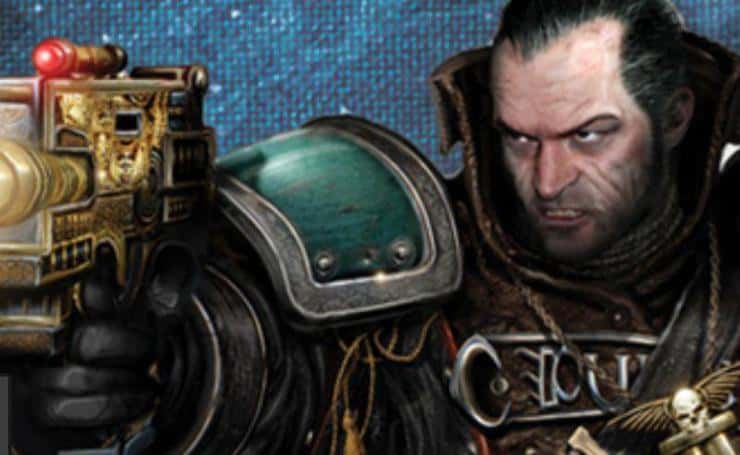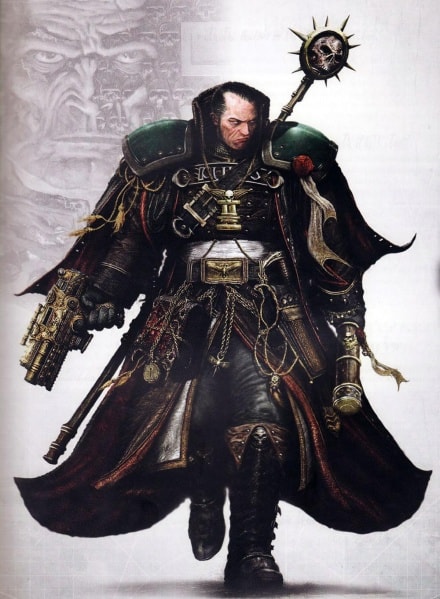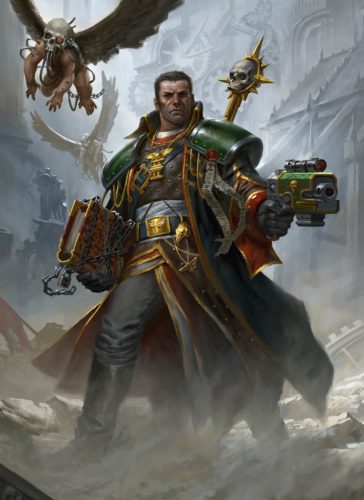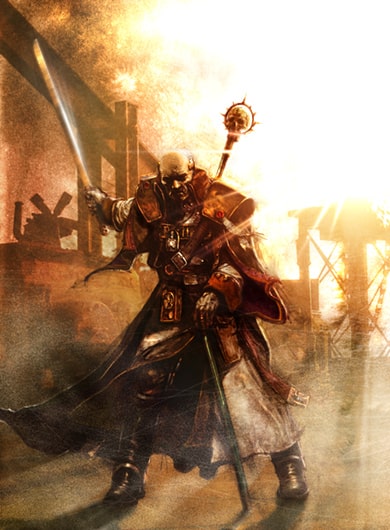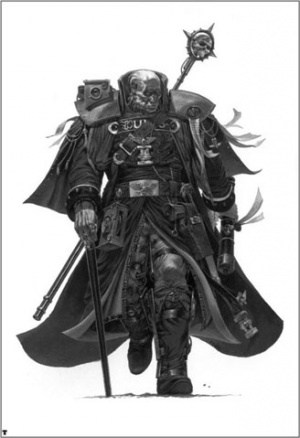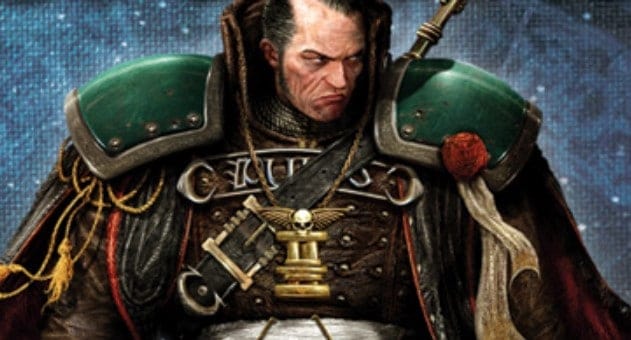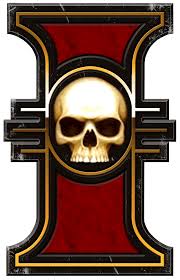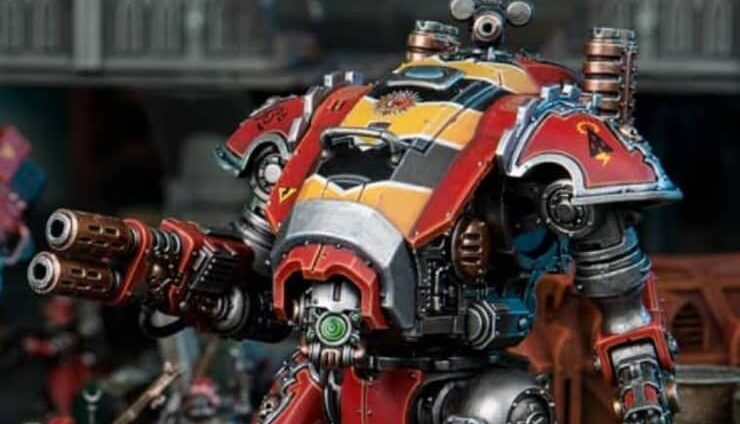With the release of the new Eisenhorn model from Games Workshop, we thought some of you would like to know the story of this iconic character. Let’s take a look.
Ever on the hunt to smite down evil, we fallow the story if one of the most famous agents of the InquisitionLets see what tales will unfold as we learn more about Gregor Eisenhorn.
Via Lexicanum:
Gregor Eisenhorn was a renowned Inquisitor of the Ordo Xenos, active during the third and fourth centuries of M41
Initially a Puritan of the Amalathian faction, Eisenhorn’s ideology would alter over the course of his career so dramatically towards Radical Xanthism that other members of the Inquisition would consider him possibly heretical. Indeed, Eisenhorn has officially been considered a rogue agent at least twice in his Inquisitorial career, only to be proved righteous both times.
History
Early Career
Born in 198.M41, on DeKere’s World, Gregor Eisenhorn became a pupil of Inquisitor Hapshant at a young age. He studied alongside fellow trainee Titus Endor and was elevated to the rank of Inquisitor in 222.M41, aged 24. His first successful persecution was that of the heretic Lemete Syre.
Carving out a stable and competent career, Eisenhorn eventually found himself being drawn into events that would change the course of his life in the year 240.M41.[During this year, Eisenhorn successfully tracked down and killed the mass-murderer Murdin Eyclone on Hubris, an investigation that is notable not only for bringing Godwyn Fischig and Alizebeth Bequin[1e] into his retinue, but also for setting him on the route of both Pontius Glaw and the Necroteuch.
The Necroteuch Affair
Following leads from the Eyclone investigation, Eisenhorn became tangled up with a heretical cabal on the world of Gudrun, and in fact was briefly captured and tortured by one of their members, Gorgone Locke. The cabal was eventually driven off Gudrun by a full Inquisitorial purge led by Inquisitor Commodus Voke.
Eisenhorn was able to recover a device known as “the Pontius” from the cabal, and it later transpired that this device held the encoded brain-engrams of the long-dead infamous heretic Pontius Glaw; one of the cabal’s schemes had involved arranging his resurrection. Eisenhorn held Pontius Glaw captive and interrogated him regularly, before finally choosing to have the Pontius device incarcerated by Magos Bure of the Adeptus Mechanicus. This decision would have a profound effect on Eisenhorn’s future.
Following up further leads from the purge of the cabal led Eisenhorn into one of his most famous investigations; the affair of the Necroteuch – a tome of chaotic knowledge. Eisenhorn tracked the survivors of the cabal to a colony world inhabited by the xenos Saruthi.
The Saruthi had come into the possession of a copy of the Necroteuch, and had translated it into their own language, creating two versions of this powerful chaotic tome and a translating tool. The human Necroteuch tome was quickly found and destroyed by Eisenhorn himself. Some radical Inquisitors deemed this a heretical act, and damned Eisenhorn for it. However, the majority of the local Inquisitorial conclave supported Eisenhorn’s decision to burn the tome, outvoting the radicals.
Eisenhorn was therefore spared from censure and was in fact instrumental in planning a raid on the Saruthi homeworld during which the remaining items were destroyed. It was during this attack that Eisenhorn also first met Cherubael, a powerful daemonhost who would plague Eisenhorn and the Imperium in later endeavours.
Sameter
The following year, 241.M41, Eisenhorn investigated apparent ritual murders on the world of Sameter, at first believing the killings to be the work of some chaotic cult. Soon, however, it was revealed that the culprits were ex-soldiers of the Imperial Guard. These former soldiers of the Sameter 9th Infantry had been driven mad by the horrors they had faced in war, and were ritually killing regular citizens. Backed up by the local Adeptus Arbites, Eisenhorn managed to corner and eliminate the fanatics in an abandoned and decaying building. During the resultant firefight Eisenhorn lost his left hand to an experienced former-sharpshooter. He was offered a prosthetic but declined, making do with a fused stump until he could have a vat-grown hand grafted on two years later.
Quixos
In 312.M41, Eisenhorn’s best friend, Midas Betancore was killed by the heretic Fayde Thuring during an investigation. Thuring escaped, and Eisenhorn promised to keep a watchful eye on Midas’ infant daughter, Medea. Years later, when she came of age, she would follow the path of her father and join the retinue of Inquisitor Eisenhorn as his pilot.[3]
26 years later, in 338.M41, Eisenhorn began the investigation that he would become most known for; the elimination of the heretic Inquisitor Quixos. The investigation took place in the aftermath of the disaster of the Thracian Primaris Triumph (where Eisenhorn’s Interrogator, Gideon Ravenor, was horrifically injured), an atrocity that appeared to have been engineered to free several alpha-plus class rogue psykers.
Eisenhorn’s investigation took him to the world of Eechan, where, posing as mutants, he and his team discovered that there was Inquisitorial collusion in the scheme that freed the psykers. Inquisitor Lyko was discovered in the company of the daemonhost, Cherubael. Taken aback by the reappearance of Cherubael, Eisenhorn focused his investigations upon the creature. This led him to Cadia, where he discovered another daemonhost, Prophaniti, and ties between these daemonhosts and the missing radical Inquisitor Quixos. However, Eisenhorn’s investigation was sidelined for some time by his arrest by Inquisitor Osma for consorting with daemons. Escaping, he was declared outcast and forced to operate as a rogue for the remainder of the investigation. Eisenhorn sojurned with his associate Magos Bure on the world of Cinchare for some time, where he conferred with his prisoner, Pontius Glaw. During this period he defeated a Chaos cult that existed on the world and gained master-crafted Force Weapons.
Eisenhorn next assembled a small strike group of three other Inquisitors, and acting in concert with them tracked down and confronted Quixos. Eisenhorn himself was the one who killed Quixos, recovered his heretical book, the Malus Codicium, and banished both Prophaniti and Cherubael. He was cleared of all charges against him at the conclusion of the investigation.
In 345.M41, Eisenhorn succeeded in secretly summoning the daemon Cherubael and trapping him for interrogation and study. In 355.M41 he dealt with a minor warp incursion on Gudrun.
Heretic
It was in the year 386.M41 that Eisenhorn was able to avenge the death of Midas Betancore, but it came at considerable cost. Killing the heretic Fayde Thuring cost him the lives of several associates, placed Bequin into a coma, resulted in the destruction of his gun-cutter and forced him to use Cherubael as an ally.
Shortly afterwards Eisenhorn was the victim of a carefully planned attack orchestrated by Pontius Glaw, who had escaped captivity and decided to punish and torment his captors. Almost every facet of Eisenhorn’s life was brought crashing down around him, including his career, as he was once again declared an outcast by Inquisitors Osma and Heldane. His organisation shattered, his own body broken and much of his retinue dead, Eisenhorn was eventually able to call on the aid of his once-pupil, Gideon Ravenor, who was now a full Inquisitor. With Ravenor’s assistance, Eisenhorn was able to track Pontius down and eliminate him for good. However, the Pontius affair did more than deplete Eisenhorn’s physical resources, it also finally broke down his resistance to employing radical methods – he began to travel with Cherubael as his constant companion.
Eisenhorn largely dropped out of sight after the Pontius affair, despite his outcast status apparently being rescinded once again. He has reappeared for only brief moments in the years following, to recruit new retainers or confer with past associates, such as warning Gideon Ravenor about the intentions of the cult known as the Divine Fratery.Later members of the cult discuss Eisenhorn and it is suggested that he may have been killed fighting their followers, as he was inside a building that they bombed, and Eisenhorn subsequently vanished from their foresight. The truth of this can be disputed.
https://www.youtube.com/watch?v=_XUtIJNCJTU[/embed}
